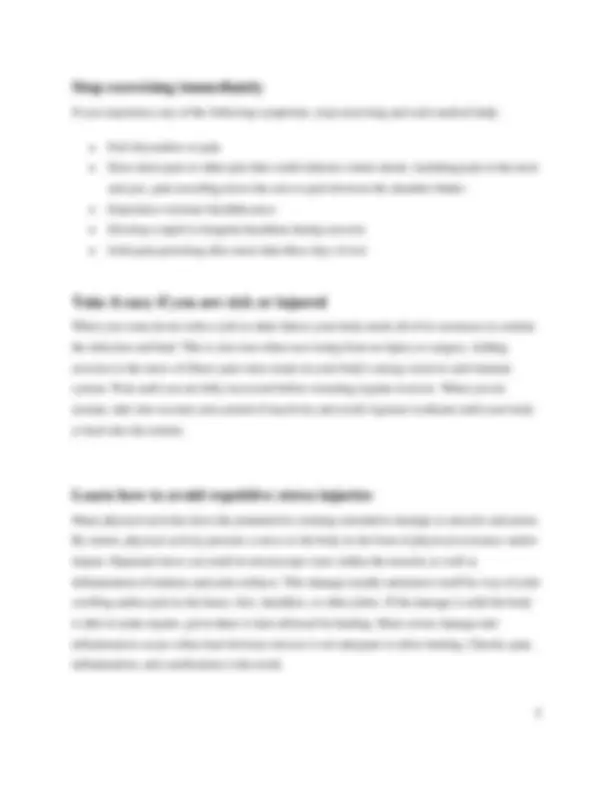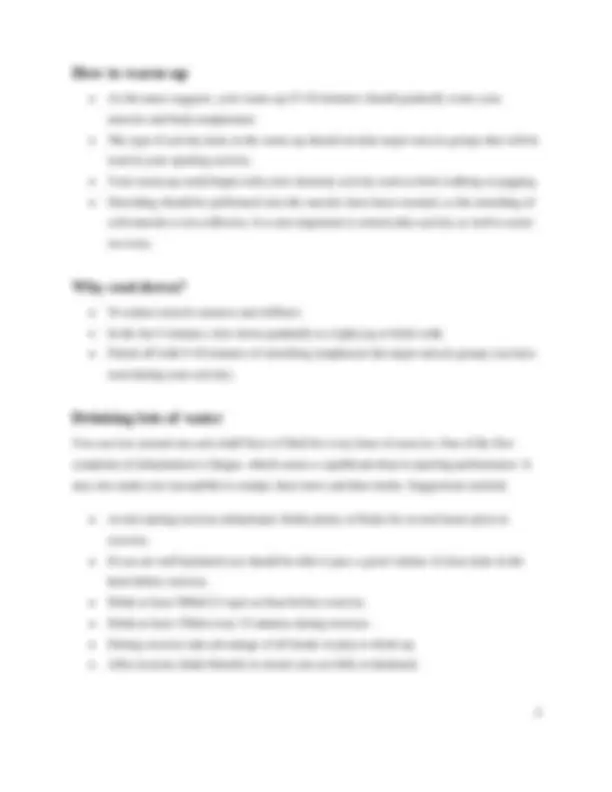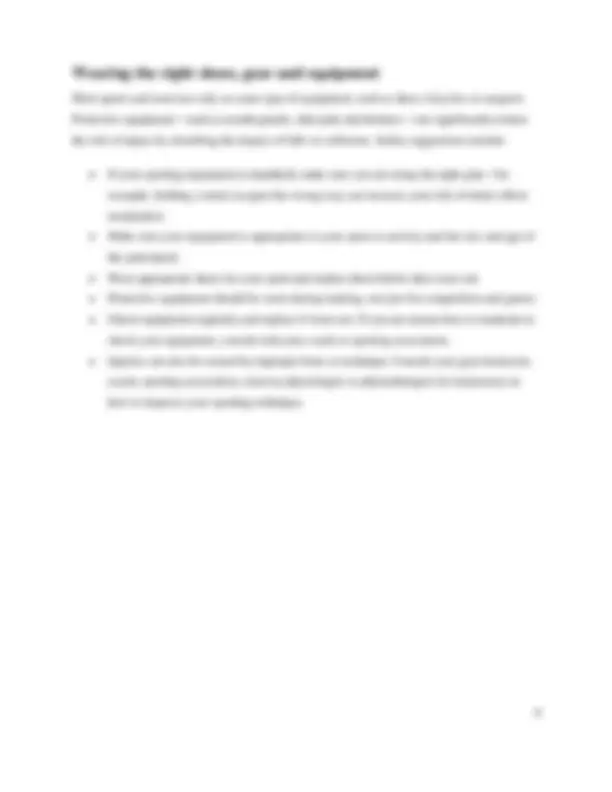





Study with the several resources on Docsity

Earn points by helping other students or get them with a premium plan


Prepare for your exams
Study with the several resources on Docsity

Earn points to download
Earn points by helping other students or get them with a premium plan
Community
Ask the community for help and clear up your study doubts
Discover the best universities in your country according to Docsity users
Free resources
Download our free guides on studying techniques, anxiety management strategies, and thesis advice from Docsity tutors
Physical Activity Readiness Questionnaire (PAR-Q) and You. Regular physical activity is fun and healthy, and increasingly more people are starting to become ...
Typology: Exercises
1 / 5

This page cannot be seen from the preview
Don't miss anything!




Regular physical activity is fun and healthy, and increasingly more people are starting to become more active every day. Being more active is very safe for most people. However, some people should check with their doctor before they start becoming much more physically active. If you are planning to become much more physically active than you are now, start by answering the seven questions in the box below. If you are between the ages of 15 and 69, the PAR-Q will tell you if you should check with your doctor before you start. If you are over 69 years of age, and you are not used to being very active, check with your doctor. Common sense is your best guide when you answer these questions. Please read the questions carefully and answer each one honestly:
Check YES or NO:
Informed use of the PAR-Q: Reprinted from ACSM’s Health/Fitness Facility Standards and Guidelines, 1997 by American College of Sports Medicine
illness such as a cold or a fever – wait until you feel better; or If you are or may be pregnant – talk to your doctor before you start becoming more active.
Please note: If your health changes so that you then answer YES toany of the above questions, tell your fitness or health professional. Ask whether you should change your physical activity plan.
If you answered NO honestly to all PAR-Q questions, you can be reasonably sure that you can: Start becoming much more physically active – begin slowly and build up gradually. This is the safest and easiest way to go. Take part in a fitness appraisal – this is an excellent way to determine your basic fitness so that you can plan the best way for you to live actively.
YES NO
physical activity recommended by a doctor?
physical activity?
pressure or heart condition?
Talk to your doctor by phone or in person BEFORE you start becoming much more physically active or BEFORE you have a fitness appraisal. Tell your doctor about the PAR-Q and which questions you answered YES. You may be able to do any activity you want – as long as you start slowly and build up gradually. Or, you may need to restrict your activities to those which are safe for you. Talk with your doctor about the kinds of activities you wish to participate in and follow his/her advice. Find out which community programs are safe and helpful for you.
Regular physical activity is vital for good health. While there is a risk of injury with any type of physical activity, the benefits of staying active far outweigh the risks. You can reduce your risk of exercise injury by following these recommendations:
You can obtain information and advice about exercise safety from your doctor, a sports medicine doctor, physiotherapist or an exercise physiologist or see a sporting association about sporting technique and equipment.
Injuries are more likely if you ignore your body’s signals of fatigue, discomfort and pain. Suggestions include: See your doctor for a full medical check-up before embarking on any new fitness program. Cross-train with other sports and exercises to reduce the risk of overtraining. Make your exercise program progressive--Respect your current fitness level by starting an exercise program at a pace and duration that you know you can maintain. Increase intensity and duration gradually. Make sure you have at least one recovery day, and preferably two, every week. Injuries need rest – trying to ‘work through’ the pain will cause more damage to soft muscle tissue and delay healing. If you have a pre-existing injury or an area that is prone to injury, consult your doctor or physiotherapist before starting. Rehabilitation exercises may help to strengthen the injured area or you may be advised to strap it prior to exercising to provide support.
As the name suggests, your warm-up (5–10 minutes) should gradually warm your muscles and body temperature. The type of activity done in the warm-up should include major muscle groups that will be used in your sporting activity. Your warm-up could begin with a low intensity activity such as brisk walking or jogging. Stretching should be performed once the muscles have been warmed, as the stretching of cold muscles is less effective. It is also important to stretch after activity as well to assist recovery.
To reduce muscle soreness and stiffness In the last 5 minutes, slow down gradually to a light jog or brisk walk. Finish off with 5–10 minutes of stretching (emphasize the major muscle groups you have used during your activity).
You can lose around one and a half liters of fluid for every hour of exercise. One of the first symptoms of dehydration is fatigue, which causes a significant drop in sporting performance. It may also make you susceptible to cramps, heat stress and heat stroke. Suggestions include:
Avoid starting exercise dehydrated. Drink plenty of fluids for several hours prior to exercise. If you are well hydrated you should be able to pass a good volume of clear urine in the hour before exercise. Drink at least 500ml (2 cups) an hour before exercise. Drink at least 150ml every 15 minutes during exercise. During exercise take advantage of all breaks in play to drink up. After exercise drink liberally to ensure you are fully re-hydrated.
Most sports and exercises rely on some type of equipment, such as shoes, bicycles or racquets. Protective equipment – such as mouth guards, shin pads and helmets – can significantly reduce the risk of injury by absorbing the impact of falls or collisions. Safety suggestions include:
If your sporting equipment is handheld, make sure you are using the right grip – for example, holding a tennis racquet the wrong way can increase your risk of tennis elbow (tendonitis). Make sure your equipment is appropriate to your sport or activity and the size and age of the participant. Wear appropriate shoes for your sport and replace them before they wear out. Protective equipment should be worn during training, not just for competition and games. Check equipment regularly and replace if worn out. If you are unsure how to maintain or check your equipment, consult with your coach or sporting association. Injuries can also be caused by improper form or technique. Consult your gym instructor, coach, sporting association, exercise physiologist or physiotherapist for instruction on how to improve your sporting technique.